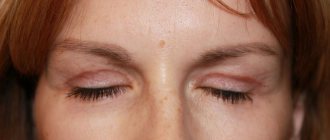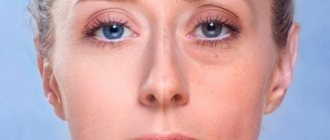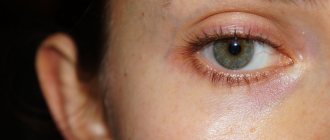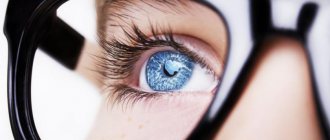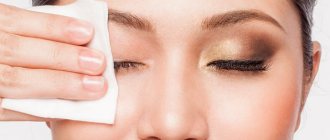Treatment options
In mild cases, to correct eversion of the eyelid, treatment may consist of compresses and ointments with an antibacterial effect.
To avoid infection, the eyelid is fixed in its normal position using a patch. Often these are not long-term measures that precede surgery. Atonic volvulus is eliminated by surgery. During the procedure, the surgeon normalizes the contact of the eyelid with the eyeball and restores eye closure during blinking. In a similar way, they get rid of the scar form of ectropion.
Correction of the paralytic type of eversion of the eyelid should begin with a consultation with a neurologist. In the process of getting rid of neuralgia, the function of the facial nerve is restored, and then the position of the skin.
In the mechanical form, the first step is to get rid of the tumor, and then normalize the position of the eyelid. The feeling that there is a foreign object in the eye can be removed with the help of eye drops prescribed by a specialist.
During surgery the following can be used:
- Blepharoplasty (using a laser or scalpel).
- Surgitron device. High-frequency radio waves dissolve damaged cells without damaging surrounding areas.
Possible complications
Mistakes made during surgery or improper further care can lead to unpleasant consequences:
- scars and cicatrices;
- hematomas;
- bleeding;
- infection;
- itching at the site of the postoperative scar;
- impaired functioning of the lacrimal gland;
- burning sensation in the eyes.
If one of the above symptoms appears, you should immediately see an ophthalmologist.
Blepharoplasty should be performed by a professional and experienced doctor. Otherwise, complications may develop.
Traditional medicine recipes
Elderly people should take special care of their eyes. To do this, you can regularly do therapeutic massage and use traditional medicine recipes:
- A daily exercise will help strengthen the eyelid and improve the health of the mucous membrane: fill a container with clean water at room temperature and dip your face in it. Then open your eyes and blink quickly a few times. Raising your face, blink a few more times. This manipulation is performed three times.
- After washing your face after a night's sleep, prepare an infusion for lotions from 1 tbsp. linden blossom and a glass of hot water. Cool the broth, moisten a double cotton pad and place it on your eyelids for 5 minutes.
These simple steps will help keep your eyes healthy.
Rehabilitation activities
In order for the rehabilitation period to be favorable, certain indications should be observed:
- instill eye drops prescribed by your doctor;
- wear sunglasses;
- perform a set of gymnastic exercises for the eyes daily;
- use high pillows for sleeping;
- do not use contact lenses;
- eliminate bad habits and caffeine;
- limit physical activity.
During the recovery period, it is strictly forbidden to visit the bathhouse, sauna and solarium. The duration of rehabilitation is two months.
The symptoms of ectropion are similar to entropion.
Getting rid of ectropion after blepharoplasty with surgery
There are two options for correcting this problem - conservative and surgical. In the first situation, massage and gymnastics are used to increase the tone of the orbicularis oculi muscle. Depending on the type of pathology, the age of the patient, and the condition of the facial tissues, different surgical techniques can be used. To select them, the doctor relies on the following factors:
- why did the inversion appear;
- what is the condition of the soft tissues in the eyelid area: excess or deficiency;
- the degree of weakness of the ligaments that fix the corners of the eye in a particular state;
- presence of scars and other skin damage.
The general essence of surgery is to move the injured musculocutaneous structure of the eyelid to the correct position and secure it. This can only be done by a plastic surgeon or an ophthalmologist in a special department. The preparatory stage begins with a meeting with the surgeon, after which the patient will need to undergo tests. The list of studies is as follows:
- general blood and urine tests;
- platelet count test;
- blood chemistry;
- electrocardiogram;
- fluorography.
Depending on age and health status, additional studies and consultations with specialists may be indicated. If the intervention will be performed under general anesthesia, it is additionally necessary to consult with an anesthesiologist. The operation itself lasts from 1 to 3 hours, it all depends on the chosen technique and the complexity of the problem.
The access incisions are located in natural skin folds and are sutured with a special cosmetic suture, so the scars will not be visible in the future.
The first day after surgery, the patient remains in the clinic under the supervision of a doctor. After discharge, you need to regularly visit the doctor to monitor tissue tightening and evaluate the result of the intervention. During the first two weeks, there will be swelling and bruising around the eyelids and middle third of the face. In the first hours and days after the intervention, swelling may increase. \
We recommend: Rules for treating chemosis with drugs after blepharoplasty
To stop this, you need to use cold compresses. For rapid tissue regeneration and resorption of swelling, it is necessary to perform physiotherapeutic measures. To prevent the occurrence of rough scars, proteolytic substances can be administered.
Contraindications, possible complications, side symptoms
The surgeon will not perform the operation in the following situations:
- diabetes;
- high blood pressure with constant sudden crises;
- severe heart and vascular diseases;
- diseases of the thyroid gland, which are accompanied by hormonal imbalance;
- dry eye syndrome;
- retinal detachment.
The most negative consequence of the intervention is that the defect often cannot be corrected 100%. A small distance between the edge of the eyelid and the eyeball may remain. There is also a risk of the eyelid turning inwards. Other possible complications include:
- bleeding wounds in the first days or after surgery;
- seam divergence;
- wound infection, the appearance of an inflammatory process;
- the appearance of rough scars in the eyelid area;
- the appearance of skin cysts;
- malfunction of the lacrimal glands;
- the appearance of blepharoptosis and lagophthalmos.
Repeat surgery will be required to correct many of these complications. The risk of their occurrence can be minimized if you adhere to the main rules during rehabilitation:
- refuse to go to baths, saunas, swimming pools - this way, swelling and hematomas will not increase in the first 14 days after the intervention;
- protect postoperative scars from exposure to direct sunlight for 6 months after surgery. This will be an ideal prevention of the formation of age spots;
- limit physical activity, refuse to perform work in an inclined position for 30 days after the intervention - this way, the tissues will heal quickly and the swelling will go away.
The main thing is not only the operation, but also postoperative rehabilitation, during which the patient must follow all the doctor’s recommendations so that no complications arise and the result does not keep you waiting long.
YouTube responded with an error: Daily Limit Exceeded. The quota will be reset at midnight Pacific Time (PT). You may monitor your quota usage and adjust limits in the API Console: https://console.developers.google.com/apis/api/youtube.googleapis.com/quotas?project=268921522881
How is the operation performed?
The algorithm for performing upper blepharoplasty involves the following stages:
- Using a special marker, the surgeon marks the skin. This manipulation facilitates correct operation during the operation.
- Anesthesia is administered: either local anesthesia or general anesthesia. The decision is made by the doctor, focusing on the amount of work and the patient’s health condition.
- Small incisions (3–5 mm) are made in places where folds form. The skin is retracted to the outer corner of the eye.
- The specialist begins to eliminate excess fat. The work of muscles and ligaments is adjusted. In some cases, surgical intervention requires fixation of the orbicularis oculi muscle by securing part of the fibers in the periosteum of the orbit. Such actions in plastic surgery are called canthopexy.
- Upon completion of all manipulations, sutures are applied, and a sterile bandage is placed at their location.
As a rule, the duration of a standard operation to remove fat from the upper eyelid does not take more than an hour. But circular plastic lasts for several hours.
There is another possibility to eliminate ptosis - laser exposure. Unlike surgery, no incisions are required. Consequently, the rehabilitation period is reduced to several days.
How to detect an eversion of the eyelid?
Typically, diagnosing extropion is not difficult: the defect can be seen by the patient himself in the mirror.
When visiting a doctor, an ophthalmologist performs standard examinations:
- External examination, which allows us to determine the presence of decreased tone of the periorbital muscle, the degree of atony, swelling of the skin, the degree of non-closure of the eyelid (lagophthalmos), the presence of tumors or scars.
- Biomicroscopy will help to examine the conjunctiva, the edges of the eyelid in more detail, and assess the size of the pathology in more detail.
- Visometry and perimetry. These studies will evaluate the impact of eversion on quality of vision.
- Computer keratometry to clarify the diagnosis.
- A series of laboratory tests on eyelid scrapings and some blood tests.
After the examination, a form of treatment for eyelid inversion is selected.
Advice. Seek advice from an ophthalmology clinic that performs ophthalmological surgeries. This way, you won’t have to do the same examinations twice.
Video: Blepharoplasty and complications after it
Discussion: 5 comments left.
Good evening. I was operated on for bags under my eyes, lower blepharoplasty. On the first day there was swelling and bags under the eyes, which actually didn’t surprise me. Then they started to go away, but a swelling appeared under the right eye, like a nut, 2 centimeters in diameter. I went to the doctor, examined him, and said it was a subcutaneous hematoma due to bleeding. He prescribed heparin ointment for its resorption and cold. Along the way, I found out that I was taking aspirin for a headache, which provoked this postoperative bleeding. Now everything is fine, if I have another operation, I will be more attentive to the recommendations regarding the postoperative period. And how I forgot about the ban on taking aspirin.
I had laser blepharoplasty done to reduce wrinkles around the eyes, otherwise the mesh was noticeable. There was practically no pain during the operation. But after that there is redness of the eyelids and their swelling. To tell the truth, I was a little worried, so they started applying cold. On day 3, the redness, swelling, and wrinkles went away. I'm glad I decided.
Hello. I had surgery for bags under my eyes; they were so bad that it felt like I wasn’t sleeping at all. The plastic surgeon said that it was necessary to remove a large amount of subcutaneous tissue from the lower eyelids. After the operation, at first everything was fine, but over time I began to notice some kind of burning sensation in my eyes. And dryness in them. After examination, they said that I had an eversion of my eyelids. Artificial tears were prescribed. It became easier. But I had to undergo another operation and underwent additional plastic surgery of the lower eyelids. Now that the swelling has subsided, it’s good, it doesn’t dry out the eyes.
Good afternoon The first day after blepharoplasty surgery seemed like a nightmare to me, although they warned me about the development of complications. I was afraid to look in the mirror - my eyelids were swollen, there were bruises under my eyes. I think this is how I fixed the bags under my eyes. The doctor prescribed cold application, forbade cosmetics and going out in the sun. After a few days the swelling went away. And only then did I notice the difference. Fortunately, the photo was taken before the operation.
We underwent lower eyelid blepharoplasty surgery. At first there was swelling and blueness under the eye at the surgery site. It even seemed that I looked worse than before this procedure. The doctor recommended applying cold. After a few days everything seemed to be back to normal. Frankly, I was scared at first, although the doctor warned me. But it’s one thing to hear, and another to see. Now everything is fine, the bags have really disappeared.
Blepharoplasty is a plastic surgery whose main purpose is to correct the upper or lower eyelids. With its help, it is possible to get rid of excess skin and fatty hernias, as well as remove prominent dark circles under the eyes. Eyelid surgery is considered a low-traumatic and very effective operation, after which the skin of the eyelids looks tightened and young.
The skin of the eyelids is a very delicate and easily vulnerable area. It is not surprising that after blepharoplasty, it is likely that a number of unpleasant complications will develop, which for various reasons cannot always be avoided.
Complications after blepharoplasty are divided into two types:
- Early (swelling, bleeding, inversion of the lower eyelid);
- Late (suture failure, tearing, keratoconjunctivitis sicca, etc.).
Reasons for appearance
Complications after eyelid correction using plastic surgery can have different origins. The reasons are divided into several groups:
Failure to comply with the conditions of preparation for blepharoplasty and postoperative rehabilitation. Usually the patient is informed about what is permitted and prohibited during these periods. Ignoring the rules can cause most complications. For example, taking blood-thinning medications provokes bleeding, swelling, and makes healing difficult. So after this you can expect any problem. The same thing happens when the patient does not want to give up smoking, starts physical activity too early, does not take good care of the stitches, and refuses procedures aimed at accelerating recovery. Even dietary disturbances, which should be light after blepharoplasty, can cause complications.
Features of the patient's body. To a greater extent, this relates to the process of scar formation. If blepharoplasty is the first procedure performed, the tendency to form hypertrophied and keloid scars on the eyelids may be an unpleasant surprise.
Symptoms of the lesion
In the initial stages of development of eversion of the eyelids, the patient may not be bothered by anything. The greater the lag between the edge of the eyelid and the eyeball, the more often inflammatory processes occur and the patient begins to experience discomfort.
The most common symptoms of ectropion are:
- Swelling of the eyelid;
- Sensation of sand or foreign body in the eyes;
- Irritation of the tissues of the eyelids and eyeball;
- Infections under an open eyelid;
- Development of keratitis and corneal opacities.
A common symptom that accompanies eversion of the eyelids is lacrimation. In the normal position of the eyelids, the tear fluid washes the conjunctiva of the eye and flows into the lacrimal punctum along the edge of the lower eyelid. If the eyelid lags behind the eyeball, the fluid washing the eye cannot take its usual path and accumulates between the eye and the eyelid, then overflowing.
Prevention of ectropion of the eyelid
There is no specific prevention to reduce the primary risk of ectropion of the eyelid. According to practicing specialists in the field of ophthalmology, a medical examination (once a year) will be sufficient. Early diagnosis followed by prescription of drug therapy will avoid surgical intervention. In order to prevent relapse of the pathology, the patient must adhere to the following rules and recommendations:
- perform daily hygienic care of the visual organs;
- when diagnosing infectious eye diseases, provide timely treatment, preventing the pathological condition from becoming chronic;
- minimize possible injuries to the eyeball;
- in the postoperative period, temporarily refrain from visiting the gym and swimming pool (limit physical activity to a minimum);
- impose a complete taboo on the consumption of alcohol and smoking;
- in sunny weather, use special cosmetics to protect against ultraviolet radiation or wear sunglasses.
Patients who have been diagnosed with ectropion of the eye need to know that the disease does not go away on its own. In some cases, even drug therapy does not have the desired effect
Particular care should be taken when using traditional healing methods, since they cannot prevent the pathological process, and superficial elimination of negative symptoms provokes the transition of the disease to an advanced form.
Useful tips
There are several ways to help your eyes recover faster after blepharoplasty. These include:
- physiotherapy;
- microcurrents;
- laser resurfacing;
- eye exercises;
- massage;
- mesotherapy;
- medicinal and cosmetic preparations.
As a rule, they are used after the rehabilitation period (after 2 weeks) to speed up the healing process.
Microcurrents
Microcurrents after blepharoplasty help rapid recovery. After the procedure, the following processes occur:
- relieves inflammation and fatigue;
- excess fluid is removed and swelling on the eyelids is reduced;
- lymph outflow improves;
- wound healing accelerates;
- muscles relax and recover.
Microcurrent therapy is also used to prevent the formation of keloid scars after blepharoplasty.
Mesotherapy
Stimulates metabolic processes, improves blood circulation and promotes cell restoration. During the procedure, injections with medicinal preparations are injected under the skin in the eyelid area, which contain amino acids, vitamins, herbal components and other beneficial substances.
Laser resurfacing
In order for blepharoplasty to proceed with a minimum of complications, laser resurfacing is recommended after it.
It is prescribed to stimulate metabolic processes, cell renewal, and smooth out scars. During the procedure, the desired areas are exposed to a carbon dioxide laser and the upper stratum corneum of the skin is cleaned. The session lasts 30–60 minutes.
After laser exposure, a slight burning sensation and peeling on the eyelids may occur, which will subside within 10 days. Laser resurfacing is prescribed no earlier than 2 months after eyelid blepharoplasty.
Drugs
They are used for the eyes after surgery, when it is necessary to relieve inflammation, restore dermal receptors, strengthen blood vessels, prevent the formation of blood clots and improve the general condition of the eyelids.
Popular means:
Lyoton - will help get rid of swelling, remove bruises, inflammation, relieve pain;
Lokoid - relieves swelling and inflammation, disinfects;
Dermatix is used to strengthen capillaries, eliminate pigmentation and soften scar tissue;
Troxevasin will also help remove bruises and swelling from the eyelids;
The drugs Kelo-lot and Contractubex work well for smoothing scars after blepharoplasty.
Among the cosmetics and folk remedies that help alleviate the condition of the eyelids during the rehabilitation period, the following can be used:
- gels with caffeine, retinol, Chinese mushroom extract;
- decoctions of chamomile, sage, juice of parsley leaves, linden, which are used as compresses for eyelids.
Eye drops
Prescribed in the first two to three days after blepharoplasty to prevent drying out and infection in the eyelid area, since the eyes are still slightly open. This could be Levomycetin or Albucid. They need to be instilled every 3-4 hours, two drops. If plastic surgery of the lower eyelids was performed, Solcoseryl gel is placed into their inner surface (conjunctiva) overnight.
Gymnastics
Regardless of whether blepharoplasty of the upper or lower eyelids was performed, special gymnastics are prescribed during the rehabilitation period. It helps tone muscles, increase blood circulation and restore eye functionality.
It is better to do it twice a day: morning and evening.
Basic exercises:
- Focus your gaze on a point above, below, left and right.
- Raise your face up and blink continuously for 30 seconds.
- Close your eyes, then open your eyes and immediately focus your gaze on a distant point in front of you.
- Place your index fingers on your temples and lightly pull the skin to the sides. The eyes are closed.
- Close your eyes and cover your eyelids with your index fingers. Without lifting your fingers (without pressure), look up.
- Tilt your head back and focus your gaze on the tip of your nose. Relax.
Each exercise should be repeated 5-7 times, with the exception of the second.
Lymphatic drainage massage
To avoid complications associated with blepharoplasty, your doctor may recommend massage. The procedure helps improve blood circulation, remove toxins and improve the functioning of lymph flows. Each movement must be performed 10 times, pressing your fingers pointwise clockwise in the following places:
- on the temples;
- from the outer edge of the lower eyelid to the inner;
- on the wings of the nose;
- moving along the upper eyelid, press from the inside of the eye to the temple.
Any physical procedures and other therapy after blepharoplasty help to recover faster. But they also have contraindications and side effects. Therefore, you should talk to your doctor about the advisability of their use.
Contraindications
There is a list of indications for which blepharoplasty should be avoided:
- problems with blood clotting;
- suffered a heart attack or stroke;
- complex stages of diabetes mellitus;
- blood pressure problems;
- retinal detachment;
- tumor neoplasms;
- kidney and liver diseases;
- period of critical days;
- pregnancy or lactation;
- diseases associated with inflammation of the eyelids;
- infectious diseases;
- inflammation of the tear ducts;
- conjunctivitis.
Failure to comply with contraindications can lead to irreversible consequences.
Blepharoplasty is completely contraindicated in the following cases:
- For hypertension
- Endocrine disorders, incl. hypo- and hyperthyroidism
- Serious diseases of the heart and blood vessels
- Kidney failure
- For diabetes
- For diagnosed eye diseases: glaucoma, xerophthalmia, retinal detachment
You should not have blepharoplasty if less than a year has passed since the previous intervention, or if you have recently undergone a serious illness or major surgery.
This operation is indicated for people in the following cases:
- Having bags under the eyes.
- Presence of wen under the eyes.
- Severe wrinkles on the lower eyelid.
- Sagging of the upper eyelid.
- Having a “heavy” look.
- The presence of various birth defects or pathologies of the eyelid.
- Acquired (after injury, surgery or burn) eyelid defects.
- Drooping of the corners of the eyes.
- Excess flesh on the lower eyelids.
Before agreeing to this operation, you must remember the following contraindications to its implementation:
- diabetes mellitus type 1 and 2;
- the presence of an inflammatory process in the body, which is accompanied by high temperature;
- acute or chronic respiratory diseases;
- hepatitis;
- severe infectious diseases;
- presence of oncological pathologies;
- pregnancy and breastfeeding;
- the patient's age is up to eighteen years;
- dry eye syndrome;
- blood clotting disorder;
- acute diseases of internal organs;
- hypertension;
- increased intracranial pressure;
- dysfunction of the thyroid gland;
- infectious diseases of the eyes or nose.
Contraindications include any acute infectious and inflammatory diseases, as well as chronic ailments at the acute stage (in such cases it is better to undergo the necessary course of therapy and wait for recovery).
The operation is not performed during menstruation.
Xerosis of the eyes (dry mucous membrane) is also a limitation to therapy.
The procedure is not performed if the patient has high blood or intraocular pressure.
Contraindications include systemic blood diseases, as well as blood clotting disorders (high risk of bleeding).
Contraindications also include cancer, diabetes and hormonal imbalances (especially when it comes to thyroid diseases).
This is why it is important to undergo a full examination before scheduling surgery.
Clinical manifestations and causes
Most often, eyelid inversion is not an independent disease, but develops as a consequence of other conditions.
It is extremely important to establish the true cause of the pathology, since further treatment tactics will depend on this
Congenital eversion
An extremely rare pathology explained by the shortened dimensions of the cutaneous-cartilaginous plate of the lower eyelid. Often combined with other autoimmune diseases.
If the deformity is not clearly expressed, the disease does not require treatment. Surgical intervention to narrow the distance to the ciliary edge is carried out only in case of a significant deviation from the norm.
For example, when a child sleeps, a gap is noticeable, during the day the baby is bothered by constant lacrimation, and vision decreases.
Spastic eversion
This form of the disease develops as a result of chronic inflammatory processes occurring in the area of the eyelids and conjunctiva.
Such conditions lead to constant tension in the muscle fibers and spasm of the orbicularis oculi muscle.
Mechanical eversion
Mechanical ectropion is a displacement of the eyelid under the pressure of a volumetric neoplasm formed in the eye area.
Most often, the pathology occurs in elderly patients. Correction of deformity is possible only after removal of the formation.
How to recognize ptosis of the upper eyelid, is treatment possible without surgery, and how effective is it?
Come here to find out how dangerous blepharoptosis is.
At this address https://cosmetolog-expert.ru/plastika-litsa/veki/uprazhneniya-ot-morshhin.html watch a video with exercises for the face against wrinkles.
Cicatricial eversion
In this case, we are talking about pulling outwards and shortening the eyelid plate as the skin scars at the site of the scar maturation.
Pathology is diagnosed at any age. The main reason is trauma, burns, surgery and some skin diseases.
Treatment is surgery to excise the scar followed by correction of the eyelid position. If the deformity is severe, skin grafting may be required.
The prognosis for patients is favorable. With ectropion due to chronic skin diseases, relapses are possible.
Paralytic ectropion
Paralytic ectropion is a drooping eyelid due to paralysis of the facial nerve and decreased tone of the facial muscles.
Treatment methods and prognosis will depend on the cause and persistence of the condition. If the condition worsens temporarily, you can get by with the prescription of moisturizing medications to prevent the cornea from drying out.
With complete paralysis of the facial nerve or progression of the disease, surgical intervention is indicated.
Age inversion
Age-related changes that occur in the skin provoke weakness of the soft tissues of the face and their drooping. With age, the degree of deformation constantly increases, causing exposure of the cornea.
A mild form of pathology usually does not require radical treatment, and all conservative methods are limited to the use of moisturizing drugs. In difficult cases, plastic surgery is required.
Definition of disease
Eversion of the eyelid is divided into several types, depending on the etiology. More precise symptoms are also associated with the species, on the basis of which the doctor makes a diagnosis:
- Congenital ectropion. This type of disease is autosomal hereditary and rarely occurs on its own (for example, the pathology is often associated with ptosis, epicanthus inversus, or blepharophimosis). Disappears spontaneously as the face grows. Relatively often affects the upper eyelids. The therapy consists of suturing the lateral edges of the eyelids and moving or transferring the skin.
- Involutional (atonic) eversion of the eyelid. It is the most common form of the disease. It is especially common in the lower eyelid in elderly patients, in whom the problem is caused by weakening of the tissue and paralysis of the pretarsal part of the orbicularis oculi muscle. The disease is accompanied by significant lacrimation, hyperemia and hypertrophy of the conjunctiva. The therapy consists of horizontal shortening of the eyelid at the site of the temporal (motor) edge, as a result of which re-adhesion (sufficient adherence) of the eyelid to the eyeball is achieved.
- Paralytic ectropion. As a result of reduced function of the circular eye muscle (m. orbicularis oculi), a person cannot completely close the eyelids, which often causes the development of lagophthalmos. The cause is often considered to be paresis of the facial nerve n.VII. Therapeutic methods include suturing the edges of the eyelid, that is, tarsography.
- Cicatricial ectropion. Occurs, in particular, as a result of tension caused by scars on the skin of the eyelids and around them (often these are formed as a result of burns, including chemical burns, trauma or cancer of the eyelids). The treatment is quite complex: Z-plasty is performed on the site of traction scars. In the case of extensive processes, the cords are excised and the skin is covered plastically from the second eyelid or from the mastoid area (processus mastoideus).
Eversion of the eyelid (another name for ectropion) by definition is a persistent defect characterized by a change in position (lag) of the ciliary edge directly from the eyeball. This is accompanied by exposure of the conjunctiva of the eye.
The mechanism of action of the disease lies in the cartilage that supports the eyelid. It is he who, under the influence of certain reasons, can turn out together with the eyelid itself. Eversion of the lower eyelid is more common; pathology of the upper eyelid is extremely rare and is usually associated with the anatomy of the eye.
Symptoms and Classification of ptosis and the occurrence of ptosis of the upper eyelid
The main symptoms are:
- visually noticeable blepharoptosis;
- sleepy facial expression (with bilateral lesions);
- formation of forehead skin wrinkles and slight eyebrow lifting when trying to compensate for ptosis;
- rapid onset of eye fatigue, a feeling of discomfort and pain when straining the organs of vision, excessive tearing;
- the need to make an effort to close the eyes;
- over time or immediately occurring strabismus, decreased visual acuity and double vision;
- “Stargazer pose” (slightly throwing the head back), especially characteristic of children and being an adaptive reaction aimed at improving vision.
The mechanism of development of these symptoms and ptosis itself is as follows. The motor functioning of the eyelid and the width of the palpebral fissure depend on the tone and contractions:
- The levator of the upper eyelid (lifting muscle), which controls the vertical position of the latter;
- The orbicularis oculi muscle, which allows you to close the eye steadily and quickly;
- The frontalis muscle, which promotes contraction and compression of the eyelid with maximum upward gaze.
Tone and contraction are carried out under the influence of nerve impulses arriving to the circular and frontal muscles from the facial nerve. Its nucleus is located in the brainstem on the corresponding side.
The levator palpebrae superioris muscle is innervated by a group of neurons (right and left bundles of the central caudal nucleus), which are part of the nucleus of the oculomotor nerve, also located in the brain. They are directed to the muscles of their own and the opposite side.
Duration of rehabilitation
Today, there are several different techniques for eyelid correction. Which one will be more effective is decided by the surgeon, taking into account the problems that need to be dealt with, the patient’s age, the condition of her skin and many other factors.
How long the rehabilitation after blepharoplasty will last directly depends on the method of its implementation.
Therefore, we can only give approximate terms of primary recovery for various types of surgery.
Circular lifting
This is the most complex and extensive intervention. It is performed only in a hospital setting under general or intravenous anesthesia.
An incision is made into the skin of the upper and lower eyelids. If necessary, excess fat and skin tissue are removed. Then neat stitches are applied. The scars are usually invisible because the incisions are made in the natural crease of the upper eyelid and under the lash line of the lower eyelid.
The risk of wound infection during circular lifting is quite high. Therefore, a sterile bandage is applied to the eyes.
The first day the patient is under constant supervision of medical staff. If healing proceeds well, the bandage is removed after 2-3 days. Now you can go home.
Transconjunctival blepharoplasty
A much less traumatic operation. Subcutaneous access to the problem area is carried out through small incisions in the mucosa. This significantly reduces the likelihood of infection and speeds up healing. After the intervention, no visible traces remain.
Transconjunctival blepharoplasty does not require a hospital stay.
Within a few hours, the patient can go home accompanied by her family.
With this eyelid lift technique, the internal sutures are made of the finest self-absorbable threads. There is no need to remove them.
To avoid sutures coming apart and wounds becoming infected, a sterile bandage should be kept on the eyes for 24 hours. It must be soaked in antiseptic.
After this type of correction, you can go back to work within 7-10 days. However, a complete return to your usual lifestyle is no earlier than in a month.
Upper eyelid lift
Performed when there is severe drooping of the eyelids.
The approach can be traditional or transconjunctival. The duration of recovery depends on whether the incision was made with a regular or laser scalpel. After the laser, the wound heals much faster, as it sterilizes it and seals small vessels, reducing the risk of bleeding.
On average, the duration of the rehabilitation period after successful blepharoplasty of the upper eyelids lasts from 7 to 12-14 days. But if various complications arise, it can increase significantly. Sometimes even repeated intervention is required.
Early difficulties
Blepharoplasty can cause serious complications after surgery
.
Let's take a closer look at each of these conditions and how you can cope with them.
Edema
Swelling of soft tissues is inherent in all surgical interventions without exception, which involve damage to the integrity of soft tissues.
When the patient has edema (in the affected area of the skin), vascular permeability increases, which leads to swelling.
This condition is considered normal after this operation. It lasts from two to seven days. Swelling can also cause blurred vision and headaches.
In order to get rid of them, you need to use anti-inflammatory ointments and gels, which will be prescribed by your doctor.
Hematoma
A hematoma can develop in the first hours after surgery or several days after it is performed.
There are three types of hematomas:
- subcutaneous
- characterized by the accumulation of ichor just under the top layer of skin due to impaired vascular function. It is eliminated using a catheter, which is inserted under the skin and pumps out excess fluid; - tense
– accompanied by profuse subcutaneous bleeding. It must be urgently eliminated by restoring the affected vessel; - retrobulbar
is the most dangerous hematoma that can develop due to damage to a large vessel. In this case, patients will experience an accumulation of blood under the eyeball. This can lead to blurred vision and pain. Such a hematoma is removed surgically.
Diplopia
Its symptoms appear almost immediately after the operation.
Most often, with diplopia, the work of the oblique muscle of the eye is disrupted. As a rule, this condition goes away on its own after 1-2 months.
Bleeding
Bleeding is the most common complication observed after blepharoplasty. It can also occur during the operation itself.
The danger with this condition is that the patient may lose too much blood, requiring additional plasma or blood transfusions. This in turn threatens blood poisoning.
Eversion of the lower eyelid
Because this operation can remove so much skin, patients sometimes experience lower eyelid inversion after the procedure. At the same time, the eye itself cannot close completely, which leads to its dryness.
In order to eliminate this condition, it is necessary:
- perform additional surgery;
- do a special massage for the eye to maintain and stretch muscle tone.
Infection of postoperative wounds
If sterility is violated during this surgical procedure, the patient runs the risk of infection in the wound.
This condition manifests itself in the form of an inflammatory process, high temperature and discharge of pus from the sutures.
Also, if an infection gets into the wound, the latter will take much longer to heal.
Orbital hemorrhage
Orbital hemorrhage is considered the most terrible consequence of blepharoplasty, as it threatens complete loss of vision.
This complication can result from a surgeon’s mistake or performing surgery on a patient with the following contraindications:
- hypertension;
- taking anticoagulants or alcoholic beverages before surgery;
- carrying out a long and complex operation.
This condition usually manifests itself within the first day after eyelid correction. It is very difficult to treat.
The most effective therapy is repeated surgery, but in severe cases there is no guarantee that lost vision will be restored.
What are the main risks of blepharoplasty?
All surgical procedures have some degree of risk. Some of the potential complications of all surgeries are listed below:
- adverse reactions to anesthesia;
- hematoma or seroma (accumulation of blood or fluid under the skin);
- infection and bleeding;
- changes in sensations;
- scarring;
- allergic reactions;
- unsatisfactory results, which may require additional procedures.
Specific risks of eyelid surgery include:
- difficulty closing the eye (which can damage the surface of the cornea);
- ectropion: a condition in which the lower eyelids appear to turn out;
- asymmetry or unbalanced eye appearance;
- double vision;
- watery or dry eyes;
- inability to wear contact lenses;
- in rare cases, loss of vision.
Additional treatment or surgery may be required to treat these complications.
If patients choose not to have eyelid surgery, in some cases the appearance of excess lower eyelid skin and fat can be improved by targeting the surface of the skin (using lasers, dermabrasion, or chemical peels) and/or injecting fillers.
Is it possible to have surgery?
Treatment of symptoms is indicated in the following situations:
- the eyelid defect is not very visible and does not require surgery;
- the inversion is provoked by another disease, the elimination of which will lead to self-correction of the ectropion, and the patient only needs to reduce the discomfort at the time of therapy;
- Full surgery is contraindicated due to health or other conditions.
The doctor prescribes medications and procedures that alleviate the condition of the patient with ectropion, as well as help avoid complications:
- artificial tear medications that moisturize the mucous membrane and surface of the eyeball. They need to be dropped into the eyes twice a day;
- if the eyelids do not close completely during sleep, then it is necessary to use a patch that will fix them in the desired position at night;
- in severe situations, when the use of moisturizers is limited, the doctor stitches the edges of the eyelids to protect the conjunctiva and eyes from drying out and infection.
We recommend: Why did bumps form after blepharoplasty?
Types and causes of extropion
In 90 cases out of 100, lower eyelid inversion is diagnosed. In this case, a number of characteristic symptoms are always detected:
- Increased lacrimation, very often non-stop.
- Redness of the eyelids and conjunctiva due to constant rubbing of the eye.
- Sensation of a foreign body or sand in the eye.
- Incomplete closure of eyelids.
There are several types of extropion, each of them has its own ways of occurrence. Often the treatment method will depend on the cause of the inversion. Ophthalmologists use the following classification.
Atonic (involutional) extropion
Occurs most often. It is also called senile, as it occurs in older people. The appearance of atonic eversion of the eyelids is correlated with the natural aging of the body and a weakening of overall muscle tone. The result of involutionary processes is sagging of the skin, which provokes eversion.
With senile extropion, bilateral inversion may be observed, which increases with age. If left untreated, the cornea becomes thickened, followed by keratinization and possibly clouding, which leads to partial blindness.
Not only surgical methods are suitable for the treatment of atonic ectropion. At first, drug therapy may be used. However, this is a temporary measure and will not completely eliminate the problem.
You can get rid of atonic ectropion through surgery. During the manipulation, a part of the skin-cartilaginous tissue is excised horizontally, which restores the natural fit of the eyelid to the eyeball. The operation can be performed in many ways and always gives a good result.
Congenital ectropion
This form refers to a congenital pathology and occurs in the perinatal period, during fetal development. There may be several types of congenital pathology, depending on which structures of the eyelid are undeveloped, but the treatment is always the same - surgery.
If the sagging is minor and there are no significant symptoms, surgery is not performed.
Cicatricial extropion
Cicatricial eversion occurs after an injury, plastic surgery on the face and eyes, eyelids, and the skin around them (blepharoplasty). Moreover, eyelid inversion after blepharoplasty occurs after several weeks or months. This is due to the fact that the incisions will take some time to heal and as the sutures dissolve and the scar forms, extropion increases.
Pathology is observed from the side of scar formation.
It is very difficult to treat eyelid inversion after blepharoplasty; in such cases it always involves surgical intervention.
Paralytic type of disease
The paralytic form of extropion is usually part of an extensive paresis or paraparesis, which affects the muscles of other parts of the face: lips, cheeks, and sometimes lower and upper limbs.
In this case, inversion and eversion of the eyelids will be treated by a neurologist. After all, complex treatment of the underlying disease will be required.
Conservative (drug treatment) is used here; surgical methods are usually not resorted to.
Possible
This category of complications after blepharoplasty, which do not always occur, but only when the postoperative and rehabilitation period is improperly managed:
- infection is a consequence of bacteria entering a postoperative wound, manifested by inflammatory processes with the possible formation of pus, this complication develops when the rules of antiseptics and asepsis are not observed during or after surgery, treatment consists of prescribing antibiotics (ceftriaxone) and washing the eyes and eyelids with antiseptic solutions (furatsilin , chlorhexedine);
- ectropion – inversion of the lower eyelids after blepharoplasty, which leads to their incomplete closure, increased dryness and keratosis of the sclera of the eyeball, treatment is only surgical, consisting of plastic surgery of the tissues and muscles of the lower eyelid;
- diplopia – double vision, caused by damage to the muscles of the eyeball after surgery, treatment consists of mandatory surgical plastic surgery of the damaged muscles with restoration of their integrity;
- Deterioration of vision is a serious complication that has many causes in its occurrence, namely a tense hematoma, leading to a deterioration in the nutrition of the retina, dry keratoconjunctivitis, which can cause the formation of an eyesore; all these causes require immediate adequate treatment.
Laser blepharoplasty allows you to minimize late and possible complications, due to the virtual absence of significant trauma to the skin and subcutaneous tissue of the eyelids.
Early complications of blepharoplasty are minimal; with proper management of the postoperative period, they resolve on their own and do not require special treatment.
These recommendations include:
- avoiding taking medications that reduce blood clotting (aspirin, acetylsalicylic acid);
- avoiding physical activity after surgery;
- a cold compress on the eyelids to prevent and reduce tissue swelling;
- You cannot use makeup after surgery;
- using special eye drops or artificial tears to prevent keratoconjunctivitis sicca;
- the use of antiseptic solutions or ointments for the eyelids will eliminate infectious complications;
- avoiding excessive insolation (exposure to sunlight) on postoperative wounds will make it possible to prevent most complications of blepharoplasty;
- the effect of high temperatures on the skin of the eyelids after surgery can increase swelling, inflammation, and provoke late bleeding, so you should avoid visiting a bathhouse or sauna.

